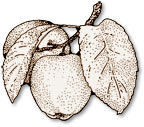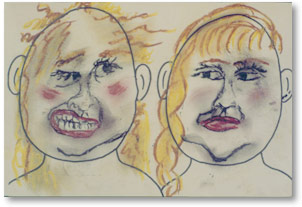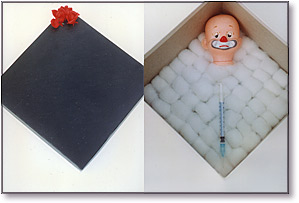
Art
Therapy and Drug Abuse
A
Personal Perspective
Ed was referred to
me by a counselor at a detox program where he had been for the past three
weeks. It was a program for wealthy professionals who were struggling
with drug dependence. After completing the detoxification process they
were referred to individual therapists in their communities who specialized
in substance abuse. The counselor felt that Ed would benefit from art
therapy because he had difficulty verbalizing feelings, and didn't know
how to talk about his substance abuse issues. Ed was extremely anxious during the first session, and it soon became apparent that now that he
had left the confines of an inpatient facility, he was struggling with
intense cravings
during the first session, and it soon became apparent that now that he
had left the confines of an inpatient facility, he was struggling with
intense cravings
to use. He feared that the only way he was able to refrain, was to be
in a controlled environment where he had no access to drugs. At fifty
one years old, he had been getting high every day since high school, and
felt that he could barely get through a day without using. He smoked marijuana
at least once a day, and over the years had become a heavy cocaine user.
As an attorney who defended high end drug dealers, he had a long history
of buying drugs from his clients. He ended up agreeing to go into detox
only after a new lawyer in their firm discovered what was going on, and
threatened to turn him in. He was
in a great deal of debt due to his drug use, was recently divorced, had
just discovered that his adolescent daughter had a drug problem of her
own, and was feeling as if his life was unraveling.
One of the first issues
we focused the art therapy on was the concept of triggers. Ed had no idea
what emotions, or situations predicated his desire to use; he was only
aware of his great longing to get high. We used a specific collage technique
to explore both the external situations that were high risk for him, and
the various emotions that he was used to managing by turning to drugs.
By responding to pictures that reminded him of his own emotions he was
unable to name, Ed began to identify his feelings for the first time,
and began to make the connection between his drug use and emotions that felt impossible
for him to tolerate. He discovered that he had always been secretly quite
shy, and that getting high helped him to relax in social situations. He
never had close friends and realized that buying drugs from his clients
made him feel liked, as well as insuring he had a steady supply of cocaine.
As his material wealth increased over the years, he felt less and less
certain that people liked him for who he was, and wondered if people invited
him to social events because they saw him as someone who could make financial
contributions to their various political and cultural causes. When Ed
was able to get in touch with his longing for real intimacy, we used a
variety of art therapy projects to help him explore the fears that had
historically held him back from risking close relationships. We also helped
him create an ongoing art therapy journal, so that when he was experiencing
the pull to use, he had a readily available means of assessing what was
going on for him emotionally at a given moment, and was able to turn to
more helpful ways of dealing with his feelings. Gradually his intense
cravings to use decreased, and as he embarked on his journey of self-exploration,
he began to create a life that included caring relationships, and real
fulfillment.
the connection between his drug use and emotions that felt impossible
for him to tolerate. He discovered that he had always been secretly quite
shy, and that getting high helped him to relax in social situations. He
never had close friends and realized that buying drugs from his clients
made him feel liked, as well as insuring he had a steady supply of cocaine.
As his material wealth increased over the years, he felt less and less
certain that people liked him for who he was, and wondered if people invited
him to social events because they saw him as someone who could make financial
contributions to their various political and cultural causes. When Ed
was able to get in touch with his longing for real intimacy, we used a
variety of art therapy projects to help him explore the fears that had
historically held him back from risking close relationships. We also helped
him create an ongoing art therapy journal, so that when he was experiencing
the pull to use, he had a readily available means of assessing what was
going on for him emotionally at a given moment, and was able to turn to
more helpful ways of dealing with his feelings. Gradually his intense
cravings to use decreased, and as he embarked on his journey of self-exploration,
he began to create a life that included caring relationships, and real
fulfillment.
Previous art experience is not necessary.
Eating Disorders
| Bulimia Anorexia Obesity Men & Weight Issues |
Chemical Dependency
|
Alcohol
Abuse Drug Abuse |
Mood Disorders
| Depression |
Contact Information